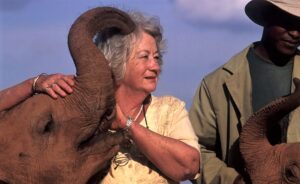» posted on Sunday, September 11th, 2022 by Linda Lou Burton
Horton’s Who in Action
Linda Lou Burton posting from Nairobi, Kenya – Blethwell began to nudge us down the Giraffe Centre’s ramp. “The Elephant Orphanage is only open one hour a day,” he explained. “We need to be there by 11.” Reluctantly we signed the Guest Book and headed for our vehicle, which Daniel had moved inside the gate, already savvy to my cane-assisted slow walk. ”Pole, pole,” he said, helping me climb the ladder-step he attached to our vehicle and offering me his arm for leverage. “Slowly, slowly.” “Pole” is pronounced “po-lay”, by the way.
 It was just four miles to Sheldrick Elephant Orphanage, which occupies an edge of Nairobi National Park. Traffic was heavy as we pulled into the drive; reservations had to be made far in advance for this special one-hour-a-day Elephant Feeding Time. Guards in uniforms, with guns, checked our ID at the gate. “We’ll have to stand back and observe,” Blethwell explained as we walked to the viewing area. “No interaction with the baby elephants is allowed, because the objective is to eventually re-integrate them into their native habitat.”
It was just four miles to Sheldrick Elephant Orphanage, which occupies an edge of Nairobi National Park. Traffic was heavy as we pulled into the drive; reservations had to be made far in advance for this special one-hour-a-day Elephant Feeding Time. Guards in uniforms, with guns, checked our ID at the gate. “We’ll have to stand back and observe,” Blethwell explained as we walked to the viewing area. “No interaction with the baby elephants is allowed, because the objective is to eventually re-integrate them into their native habitat.”
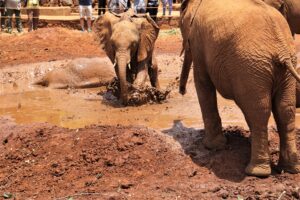
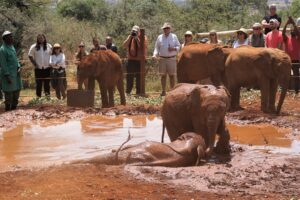
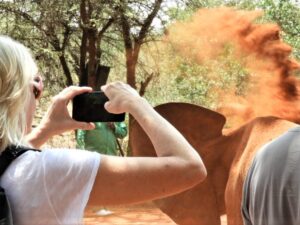 I found a bench on a raised terrace for watching, but Rick moved closer to the rope-enclosed ring, which was already surrounded by camera-toting viewers, already snapping pictures of the cutest scene since God made mud puddles. MUD PUDDLES! What kid can resist a MUD PUDDLE? A 2-year-old toddler elephant may weigh 1,900 pounds, but no amount of weight interferes with FUN. Splashing battles! Plopping flat right in the middle of the clay-red messy waters of the Baby Pond. Grabbing a trunkful of red clay dust and flinging it in the air to dry off.
I found a bench on a raised terrace for watching, but Rick moved closer to the rope-enclosed ring, which was already surrounded by camera-toting viewers, already snapping pictures of the cutest scene since God made mud puddles. MUD PUDDLES! What kid can resist a MUD PUDDLE? A 2-year-old toddler elephant may weigh 1,900 pounds, but no amount of weight interferes with FUN. Splashing battles! Plopping flat right in the middle of the clay-red messy waters of the Baby Pond. Grabbing a trunkful of red clay dust and flinging it in the air to dry off.
I thought cuteness had peaked off the scale, but no – a troop of “surrogate mothers” came marching out loaded with giant baby bottles and slurping time began. Our Master of Ceremonies explained that the formula is NOT elephant milk, but a mixture of coconut milk (closest to mother’s in fat content) and vitamins. As each baby slurped the treasured nectar, the name of each of the 27 babies was called out; each one’s age, where it was found and rescued, and the circumstances that created its “orphan” status. A mother who was killed by a poacher? A mother who died of starvation? A mother who was lost?
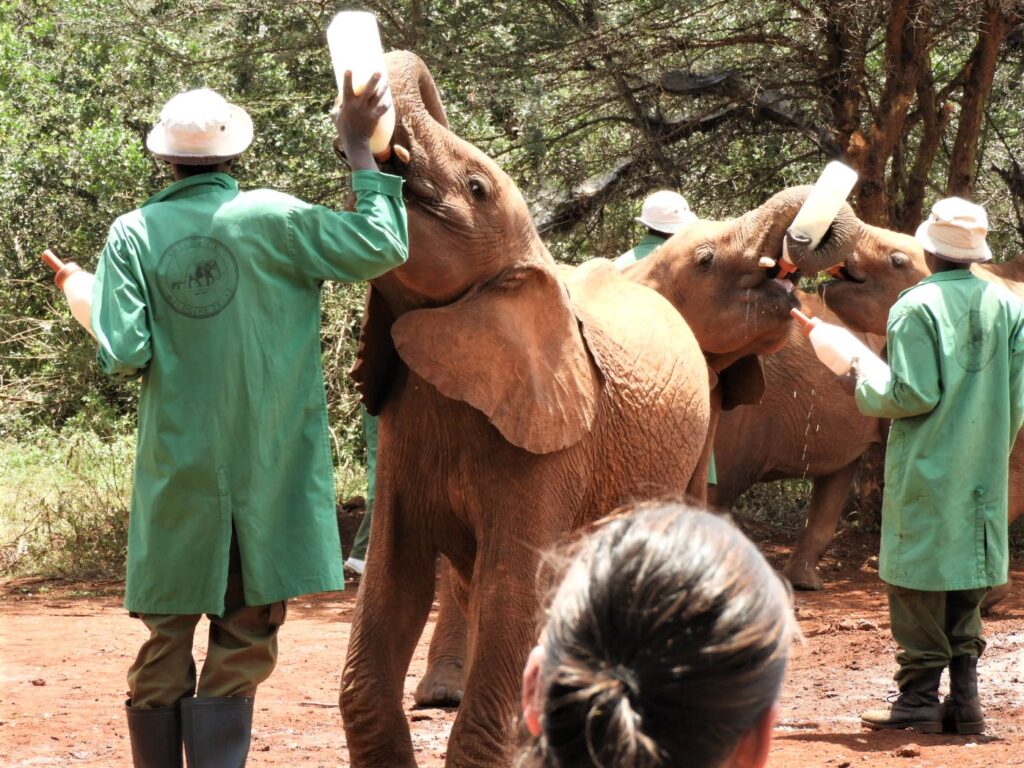 The tales of rescue and survival moved our attention back and forth. Heart wrenching cruelty. Loving 24-hour attention. Remember Horton Hears A Who from your Dr Seuss days? It made me think of that. The MC went on to tell us about each baby’s “keeper” – the green-coated boot-wearing guys who were handing off baby bottles as we watched. Here is the story of a baby’s evening:
The tales of rescue and survival moved our attention back and forth. Heart wrenching cruelty. Loving 24-hour attention. Remember Horton Hears A Who from your Dr Seuss days? It made me think of that. The MC went on to tell us about each baby’s “keeper” – the green-coated boot-wearing guys who were handing off baby bottles as we watched. Here is the story of a baby’s evening:
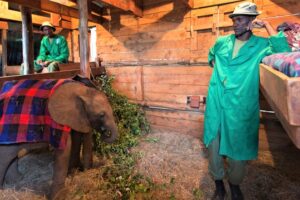 Each bedroom is stocked with a fresh layer of hay, a bundle of cut greens, and two bottles of warm milk. Freshly laundered blankets sit neatly folded over stable doors, ready to be tied around the babies bellies. The orphans know which room is theirs and make a beeline for it, eager to settle down for the evening. The Reintegration Units have communal sleeping arrangements, but the Nursery orphans have individual stockades. Baby elephants are very fragile and, in the wild, they sleep protectively cocooned by their herd. We replicate that experience through cozy, hay-lined quarters. Of course, they never sleep alone; a Keeper bunks with each baby, providing company, care, and milk feedings throughout the night. They are often called upon to give the babies a reassuring cuddle when thunder and rain batters the stable roof.
Each bedroom is stocked with a fresh layer of hay, a bundle of cut greens, and two bottles of warm milk. Freshly laundered blankets sit neatly folded over stable doors, ready to be tied around the babies bellies. The orphans know which room is theirs and make a beeline for it, eager to settle down for the evening. The Reintegration Units have communal sleeping arrangements, but the Nursery orphans have individual stockades. Baby elephants are very fragile and, in the wild, they sleep protectively cocooned by their herd. We replicate that experience through cozy, hay-lined quarters. Of course, they never sleep alone; a Keeper bunks with each baby, providing company, care, and milk feedings throughout the night. They are often called upon to give the babies a reassuring cuddle when thunder and rain batters the stable roof.
Sheldrick Elephant Orphanage now ranks in my Top Ten List of Inspiring Places, to be sure. Definitely a HORTON action! I want you to go to the Sheldrick Wildlife Trust website before you do another thing and read about all the things they do. Excellent videos put you RIGHT THERE; many stories to read; and best of all, you can become, a “digital parent” by adopting an orphaned baby yourself. This is an organization you will no doubt contribute to. Generously.
Sheldrick Wildlife Trust: https://www.sheldrickwildlifetrust.org/about
Mission & History
 Born from the Sheldrick family’s passion for Kenya and its wilderness, the Sheldrick Wildlife Trust was established 45 years ago and is best known for its Orphans’ Project, the first and most successful elephant orphan rescue and rehabilitation program in the world. The Sheldrick Wildlife Trust is a pioneering conservation organization based in Nairobi, Kenya, dedicated to the protection of wildlife and the preservation of habitats in East Africa. The Sheldrick Wildlife Trust is a separately registered charity in the UK and is directly supported by Sheldrick Wildlife Trust USA, a registered 501(c)(3) in the United States.
Born from the Sheldrick family’s passion for Kenya and its wilderness, the Sheldrick Wildlife Trust was established 45 years ago and is best known for its Orphans’ Project, the first and most successful elephant orphan rescue and rehabilitation program in the world. The Sheldrick Wildlife Trust is a pioneering conservation organization based in Nairobi, Kenya, dedicated to the protection of wildlife and the preservation of habitats in East Africa. The Sheldrick Wildlife Trust is a separately registered charity in the UK and is directly supported by Sheldrick Wildlife Trust USA, a registered 501(c)(3) in the United States.
Projects
 Orphans Project: At the heart of the Sheldrick Wildlife Trust’s conservation activities is the Orphans’ Project, which has achieved world-wide acclaim through its hugely successful elephant and rhino rescue and rehabilitation program.
Orphans Project: At the heart of the Sheldrick Wildlife Trust’s conservation activities is the Orphans’ Project, which has achieved world-wide acclaim through its hugely successful elephant and rhino rescue and rehabilitation program.
Aerial Surveillance: The Aerial Unit patrols daily to monitor wildlife and deter illegal activity, while offering rapid response assistance to anti-poaching activities and incidents of human-wildlife conflict in the Tsavo Conservation Area and Lamu District.
Anti Poaching: Ivory and rhino horn poaching have a devastating effect on Africa’s wildlife. Accompanied by armed KWS Rangers and supported by Aerial and Canine Units, last year 25 front-line teams patrolled 35,440 miles on foot, recovering and destroying 9,377 snares, seizing 120 weapons, and making 318 arrests.
 Canine Unit: Globally, the trade in illegal wildlife is estimated at $20 billion. Trained tracker dogs and their handlers detect illegal wildlife products, such as ivory, rhino horn, bushmeat, guns, and ammunition, as well as follow poachers’ tracks. Canines are able to detect the smallest trace of scent or footprints.
Canine Unit: Globally, the trade in illegal wildlife is estimated at $20 billion. Trained tracker dogs and their handlers detect illegal wildlife products, such as ivory, rhino horn, bushmeat, guns, and ammunition, as well as follow poachers’ tracks. Canines are able to detect the smallest trace of scent or footprints.
Veterinary Units: Six fully equipped Mobile Veterinary Units respond to wildlife emergencies from snares, spears, arrow and gunshot wounds, working in diverse habitats. 3,204 elephant cases have been treated, and 6,474 other wild animals.
Saving Habitats: Erecting and maintaining fencelines to secure wildlife areas and reduce human-wildlife conflict and providing financial support to empower community-led initiatives to protect areas of biodiversity, in 2020 2,019,480 acres of land were protected with partners, and 500,000+ trees planted.
Water for Wildlife: Construction of a dam outside Amboseli NP, drilling and maintaining 32 boreholes that operate on wind and solar energy in three NP’s, and operating 8 large-capacity water bowsers for emergency water relief are some of the ways SWT works to alleviate the horrific drought problems in Kenya today.
Community Outreach: Dedicated to educating and informing the younger generation about the positive impacts native wildlife can bring to their country, SWT funds more than 60 school field trips per year. Over 24,000 Kenyan school children attend the 11-12 daily mud bath at the Nairobi Orphanage every year.
Dame Daphne Sheldrick (1934-2018), founder of Sheldrick Wildlife Trust

